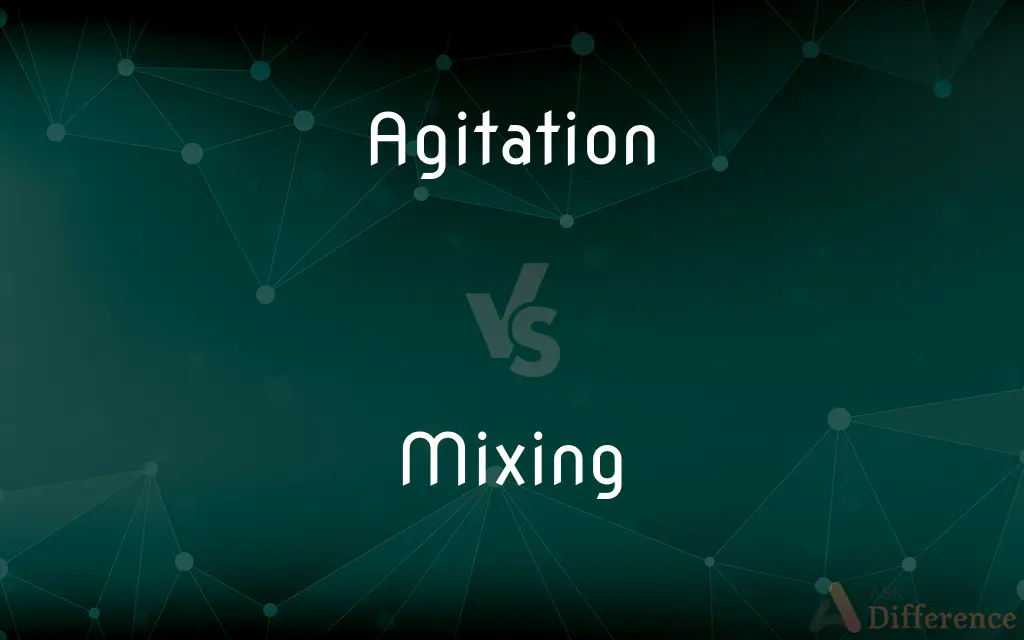Agitation vs. Mixing — What's the Difference?
Edited by Tayyaba Rehman — By Urooj Arif — Updated on May 3, 2024
Agitation involves moving a substance by shaking or stirring to mix, while mixing combines materials more gently and thoroughly to homogenize.

Difference Between Agitation and Mixing
Table of Contents
ADVERTISEMENT
Key Differences
Agitation typically employs mechanical forces like shaking or stirring, which can introduce air into substances, enhancing mixing or promoting chemical reactions. On the other hand, mixing often involves more gentle or sophisticated methods such as folding or blending, aiming for a smooth, uniform consistency without introducing air.
Agitation is often used in industrial settings where rapid movement is necessary to prevent settling or to maintain a uniform mixture during processing. Whereas mixing is crucial in culinary and pharmaceutical contexts, where precise and gentle blending affects the product's quality and effectiveness.
Agitation can sometimes lead to the degradation of the components due to the vigorous nature of the process, especially sensitive molecules in biotechnological applications. Conversely, mixing methods are typically designed to protect the integrity of ingredients, using slower or more controlled techniques.
In the context of cleaning, agitation refers to the process of disturbing the surface to loosen dirt, often seen in washing machines. Mixing, however, usually involves combining various cleaning agents to enhance effectiveness without necessarily involving vigorous movement.
While agitation is effective for increasing the rate of dissolution or reaction in chemical processes, mixing is often aimed at achieving homogeneity and consistency in mixtures like doughs, batters, or chemical solutions.
ADVERTISEMENT
Comparison Chart
Definition
Shaking or stirring a substance
Combining substances to achieve homogeneity
Typical Use
Industrial processes, cleaning
Cooking, pharmaceuticals, manufacturing
Mechanism
Rapid, often vigorous movement
Gentle, thorough combining techniques
Effect on Materials
Can introduce air, cause degradation
Protects integrity, ensures uniformity
Desired Outcome
Prevent settling, increase reaction rates
Homogeneous, consistent mixture
Compare with Definitions
Agitation
Industrial stirring to maintain substance uniformity.
Continuous agitation prevents the chemicals from settling.
Mixing
The process of amalgamating various components.
Thorough mixing is required to prepare homogeneous pharmaceutical creams.
Agitation
Shaking a liquid vigorously to mix ingredients.
Agitation of paint ensures it is mixed well before use.
Mixing
Combining ingredients to achieve a consistent texture.
Mixing the batter properly is key to smooth pancakes.
Agitation
Stirring a mixture rapidly.
Agitation is necessary to dissolve sugar in iced tea.
Mixing
Gentle blending of substances.
Mixing fragrances involves careful balance and precision.
Agitation
The process in washing machines that loosens dirt.
Effective laundry often requires good agitation.
Mixing
In cooking, combining ingredients to form dishes.
Proper mixing techniques are essential for baking success.
Agitation
In biotech, shaking cultures to increase oxygen flow.
Agitation is crucial for aerobic bacterial growth.
Mixing
Industrial blending of materials.
Cement mixing must be done thoroughly to ensure strength.
Agitation
The act of agitating or the state of being agitated.
Mixing
To combine or blend into one mass or mixture
Mix the dry ingredients first.
Agitation
Extreme emotional disturbance; perturbation.
Mixing
To create or form by combining ingredients
Mix a drink.
Mix cement.
Agitation
The stirring up of public interest in a matter of controversy, such as a political or social issue.
Mixing
To add (an ingredient or element) to another
Mix an egg into batter.
Agitation
The act of agitating, or the state of being agitated; the state of being disrupted with violence, or with irregular action; commotion.
During a storm the sea is in agitation.
Mixing
To combine or join
Mix joy with sorrow.
Agitation
A disturbance of personal tranquillity; disturbance of someone's peace of mind.
She causes great agitation within me.
Mixing
To bring into social contact
Mix boys and girls in the classroom.
Agitation
Excitement of public feeling by discussion, appeals, etc.
The antislavery agitation
Labor agitation
After this conflict pro-independence agitation temporarily died down.
Mixing
To produce (an organism) by crossbreeding.
Agitation
(archaic) Examination or consideration of a subject in controversy, or of a plan proposed for adoption; earnest discussion; debate.
Mixing
To combine (two or more audio tracks or channels) to produce a composite audio recording.
Agitation
The act of agitating, or the state of being agitated; the state of being moved with violence, or with irregular action; commotion; as, the sea after a storm is in agitation.
Mixing
To produce (a soundtrack or recording) in this manner.
Agitation
A stirring up or arousing; disturbance of tranquillity; disturbance of mind which shows itself by physical excitement; perturbation; as, to cause any one agitation.
Mixing
To become combined or blended together
Stir until the eggs mix with the flour.
Agitation
Excitement of public feeling by discussion, appeals, etc.; as, the antislavery agitation; labor agitation.
Mixing
To be capable of being blended together
Oil does not mix with water.
Agitation
Examination or consideration of a subject in controversy, or of a plan proposed for adoption; earnest discussion; debate.
A logical agitation of the matter.
The project now in agitation.
Mixing
To associate socially or get along with others
He does not mix well at parties.
Agitation
A mental state of extreme emotional disturbance
Mixing
To mate so as to produce a hybrid; crossbreed.
Agitation
A state of agitation or turbulent change or development;
The political ferment produced a new leadership
Social unrest
Mixing
To become involved
In the case of a family argument, a friend should not mix in.
Agitation
The feeling of being agitated; not calm
Mixing
A combination of diverse elements
The downtown has a good mix of stores and restaurants.
Agitation
Disturbance usually in protest
Mixing
A mixture of ingredients packaged and sold commercially
A cake mix.
Agitation
The act of agitating something; causing it to move around (usually vigorously)
Mixing
A recording that is produced by combining and adjusting two or more audio tracks or channels.
Mixing
An animal resulting from interbreeding, especially a dog or cat of mixed breed.
Mixing
Present participle of mix
He is mixing the paint.
Mixing
The act, or the result of making a mixture.
No two mixings of these paints are ever the same.
Mixing
(statistics) Of a stochastic process, to be asymptotically independent (in a precise mathematical sense).
A strictly stationary and mixing process with finite expectation satisfies a Law of Large Numbers.
Mixing
The act of mixing together;
Paste made by a mix of flour and water
The mixing of sound channels in the recording studio
Common Curiosities
What is mixing?
Mixing is the process of combining two or more substances to achieve a uniform consistency.
How does agitation affect the mixing process?
Agitation can speed up mixing by introducing more dynamic movement, but it may also introduce air or cause shear stress.
What tools are used for mixing?
For mixing, tools such as mixers, blenders, spoons, and whisks are used, varying widely from kitchen implements to large industrial machinery.
What tools are used for agitation?
Tools for agitation often include shakers, stirrers, and agitators, which are primarily used in laboratories and industrial settings.
What are the disadvantages of excessive agitation?
Excessive agitation can lead to the formation of unwanted foam, air bubbles, and may cause shear damage to delicate components or ingredients.
What are the key factors to consider when mixing substances in a lab?
Key factors include the solubility of components, required homogeneity, reaction temperature, and the sensitivity of materials to shear and heat.
hat is agitation?
Agitation refers to the vigorous movement of a substance, typically a fluid, to promote mixing or chemical reactions.
Why is agitation important in industrial processes?
Agitation is crucial in industrial processes to maintain even consistency, prevent the settling of particles, and improve heat transfer and reaction rates.
Are agitation and mixing used together?
Yes, in many processes, both agitation and mixing are employed to enhance the effectiveness of blending and reaction rates.
Can agitation replace mixing in recipes?
Not typically; while agitation can help in mixing ingredients, it often lacks the gentle touch needed for delicate recipes.
What role does mixing play in the pharmaceutical industry?
In the pharmaceutical industry, mixing is vital for ensuring the even distribution of active ingredients, which is critical for drug safety and efficacy.
How does the speed of mixing affect the final product?
The speed of mixing can dramatically affect the final product’s texture and homogeneity; slower speeds are typically used for delicate ingredients to avoid degradation.
How do you choose between agitation and mixing for a specific application?
The choice between agitation and mixing depends on the desired outcome, the nature of the materials involved, and the specific requirements of the process, such as speed, gentleness, and thoroughness.
Is mixing always necessary in chemical reactions?
While not always necessary, mixing is often crucial in chemical reactions to ensure that reactants are uniformly distributed, which can affect the rate and outcome of the reaction.
Can agitation be used in food preparation?
Yes, agitation is used in food preparation, especially in processes like marinating or when quick incorporation of ingredients is needed, though care must be taken to avoid over-mixing.
Share Your Discovery

Previous Comparison
Semi vs. Demi
Next Comparison
Hump vs. HumpbackAuthor Spotlight
Written by
Urooj ArifUrooj is a skilled content writer at Ask Difference, known for her exceptional ability to simplify complex topics into engaging and informative content. With a passion for research and a flair for clear, concise writing, she consistently delivers articles that resonate with our diverse audience.
Edited by
Tayyaba RehmanTayyaba Rehman is a distinguished writer, currently serving as a primary contributor to askdifference.com. As a researcher in semantics and etymology, Tayyaba's passion for the complexity of languages and their distinctions has found a perfect home on the platform. Tayyaba delves into the intricacies of language, distinguishing between commonly confused words and phrases, thereby providing clarity for readers worldwide.
















































